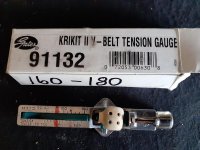StevenQ
New member
After doing quite a bit of research, I find that there are several types of the Krikit belt tension tools. I have a 2017 Spyder RT SE6, and I can't seem to find out which Krikit tool to buy. I also just had the Front Sprocket Recall done, after waiting 2 1/2 months for the sprocket to come in. While driving into our driveway, I noticed a humming sound coming from the area of the new sprocket. I looked at the belt, which seemed to be quite tight. That is what started me looking into belt tensions, etc.
I found information for the Krikit up to 2015, and posts regarding 2020-2021 Spyders, but nothing in between. Any help would be greatly appreciated, as to what/which Krikit I should buy. Also, would a reading of 180 or so of belt tension probably work best for our 2017 RT SE6?
I found information for the Krikit up to 2015, and posts regarding 2020-2021 Spyders, but nothing in between. Any help would be greatly appreciated, as to what/which Krikit I should buy. Also, would a reading of 180 or so of belt tension probably work best for our 2017 RT SE6?
Last edited by a moderator:

